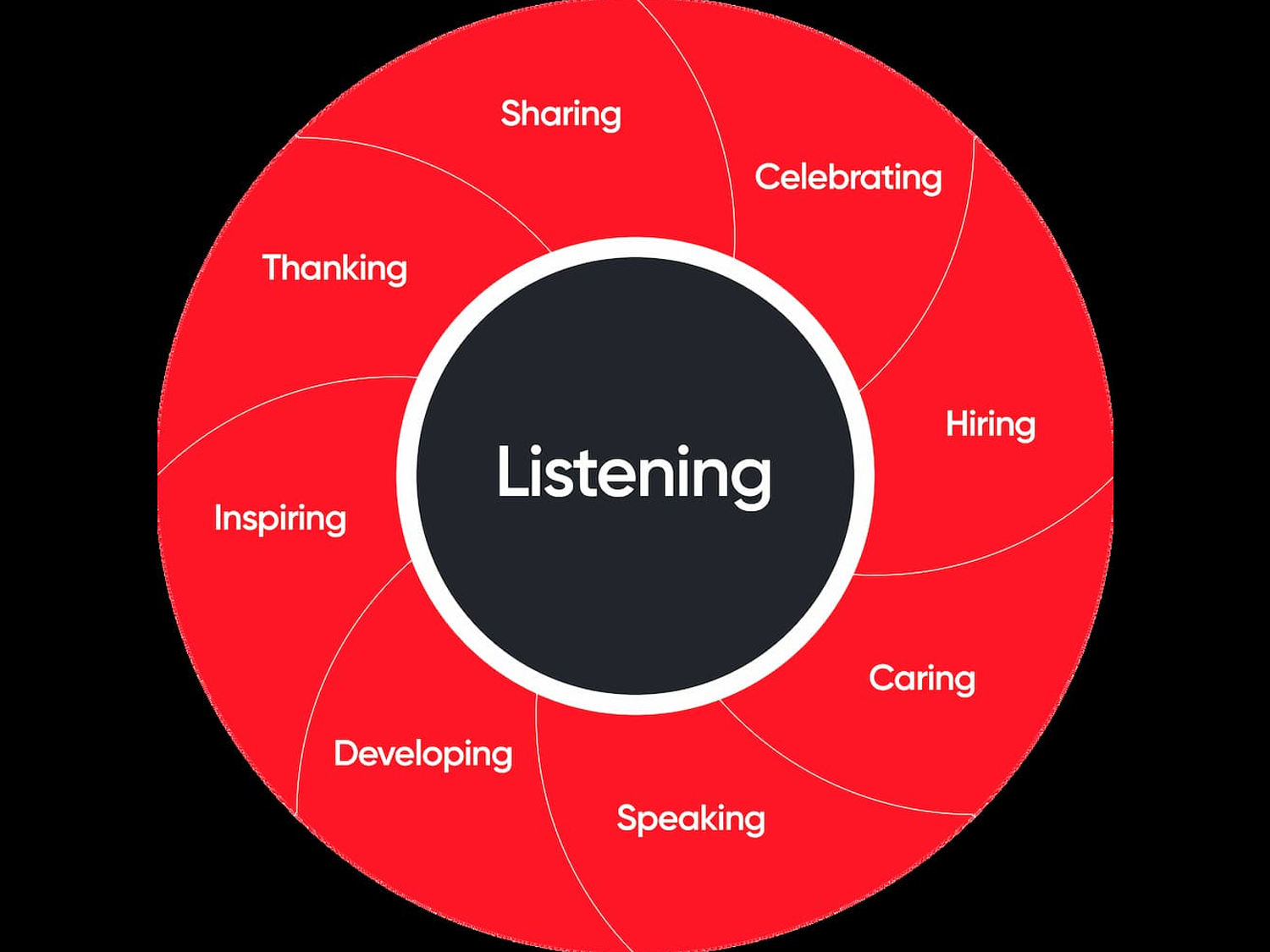Employee Experience, Employee Surveys, Layoffs, Managerial Communication, Speaking
Data shows that transparent engagement with employees during a reorganization builds trust. Here’s why that should include surveys and listening sessions.
Even when making hard choices like laying off employees, companies can build trust with workers.
While research shows that laying the groundwork ahead of a layoff is crucial for building relationships with employees and preserving trust, there are options for companies once a layoff has taken place.
PwC’s 2023 Trust Survey identified five opportunities for companies to build trust with workers during or after a layoff. More than half of employees surveyed agreed that trust could be built by:
- Encouraging managers to increase communications with remaining team members (58%)
- Offering generous severance packages (57%)
- Being more transparent about the reasons for a layoff (57%)
- Providing outplacement services to employees who are laid off (53%)
- Hosting firmwide meetings to highlight company commitment to remaining employees (50%)
While 80% of employees surveyed said layoffs negatively impact trust in companies, just 55% said the way their company conducted a layoff damaged trust. That gap paints a compelling picture for business leaders about the value of reengaging your remaining workforce after a layoff.
Giving employees a voice
Even at great companies, sometimes the business requires making the painful decision to eliminate roles.
At Camden Property Trust, No. 33 on the Fortune 100 Best Companies to Work For® List in 2023, a need to streamline operations led to a reorganization starting in February of 2022. To keep employees informed and engaged, the company brought them into the process right from the beginning.
“In planning for our reorganization, we involved our on onsite teams and district managers in the decision-making process to determine what efficiencies and changes made sense for our business,” says Allison Dunavant, VP of organizational development at Camden.
Seeking employee input when making the tough decision to restructure or conduct a layoff can be daunting for business leaders. However, a commitment to deep listening opened new doors for Camden during the restructuring process.
“We recognized that with massive change, we weren’t going to get everything right,” Dunavant says. The only way to identify missteps was to engage with people at all levels for feedback.
“We did this through establishing working groups that involved all levels of employees, and solving issues that were important to them and important to the business,” Dunavant says.
“The message for us was ‘We’re listening.’" - Allison Dunavant, VP of organizational development at Camden
Building connection
Camden’s working groups offer an example of how to accomplish several of the goals Great Place To Work® research has outlined for companies facing a layoff decision:
- Reengage remaining workers around the purpose of the organization
- Offer a safe space for employees to work through challenges posed by workforce changes
- Increase touchpoints between managers and employees
Working groups at Camden were gathered right after the restructuring and immediately started offering feedback on processes that weren’t working. “They were honest,” Dunavant says. “We realized that the only way to eat the elephant is one bite at a time.”
“Remind leaders that vulnerability is OK.” - Allison Dunavant, VP of organizational development at Camden
The working groups also became essential partners for piloting new programs.
“We would give them some solutions and say, ‘Go try this out this week and bring it back to us next week. Let us know how it went. Talk to your teams, talk to your peers, see what they think,’” Dunavant says.
As a result, the company was able to move much faster, and group participants were more engaged after seeing their feedback incorporated by the company.
“They’re also developing as leaders,” Dunavant says of group participants. “I’ve started to see a lot of these individuals as future leaders in our company, and they feel empowered to be able to make change because we’ve given them a space to do it.”
These working groups were so successful that Camden kept them even after completing its restructuring.
Participants in the working group deeply valued their opportunity to contribute to the future of Camden, and even saw the working groups as opportunities to reinforce relationships with their colleagues across the business.
“Our group is full of amazing leaders from all over the country, but we have one goal in mind: to improve our processes at Camden for our employees and our customers,” shares one general manager who participates in one of the groups. “This group fosters a safe, open space to talk about things honestly, to be real. And of course, in true Camden fashion, we also know how to have a lot of fun.”
Save the date: Attend our annual company culture conference May 7-9, 2024
Anxiety over a backlash
Why don’t more companies do everything they can to engage employees during a layoff or restructuring effort?
“The message for us was ‘We’re listening,’” says Dunavant, but stresses the importance of backing up that message with real listening programs. “Building trust is about delivering consistently — and that’s what we knew we had to do.”
Managers need resources and training to effectively respond to employee concerns in the wake of a layoff. Dunavant offered some tips:
1. Recognize the elephant in the room.
Start by addressing the concerns of employees when facing layoffs or restructuring. “Acknowledge the change and ask your team members how they’re doing,” Dunavant says.
2. Listen more than you talk.
“Be keenly observant of employees’ needs and offer encouragement and support,” Dunavant says. “Never say ‘I know how you’re feeling,’ because you don’t.”
3. Be honest — and admit what you don’t know.
“No one expects you to know all the answers or even understand how a change might impact somebody else,” she says.
4. Go beyond the survey.
“Put time and resources behind finding new ways and inventive ways to enroll them in the process of your future organization,” Dunavant advises.
Making surveys successful
Employee surveys are incredibly valuable in the wake of layoffs or restructuring. Surveys can identify opportunities for improvement, and ensure that workers remaining at your organization don’t disengage.
For leaders who are anxious about fielding a survey that might surface bad news, Dunavant recommends leaning into the discomfort.
“It’s good for us to recognize the anxiousness,” she says. “Remind leaders that vulnerability is OK.”
It also helps to have a clearly defined purpose that can offer a call to action for both employees and leaders.
“The best thing a leader can do is recognize that change is hard — and enroll their employees in how to move through the hard,” Dunavant says.
Make sure you have resources to react and investigate the survey responses.
“Don’t engage in a listening campaign if you aren’t ready to recognize where you might have opportunity and be willing to make changes accordingly,” Dunavant warns.
Business results
When companies commit to listening while trying to reshape their workforce, the benefits go far beyond employee goodwill.
For Camden, engaging its employees to build a better workplace is a core part of its strategy to drive business results.
“The formula’s easy,” says Dunavant. “Engaged employees equals process improvement, which is a better customer experience, which leads to business results. Great employee experiences lead to great customer experiences.”
When you reengage employees in the wake of a layoff, you build trust that future layoffs are a last resort. When employees trust managers to do everything in their power to avoid a layoff, the business benefits. Employees are:
- 9x more likely to give extra effort
- 2x more likely to adapt quickly to business changes
- 4x more likely to stay with their company
With those results in mind, leaders should consider every opportunity to increase communication with employees after a layoff.
Start your survey
Want to learn how employees are responding to recent workforce changes? Use our industry-leading Trust Index™ Survey to identify opportunities to reengage your people.











